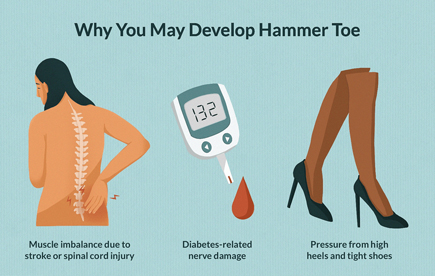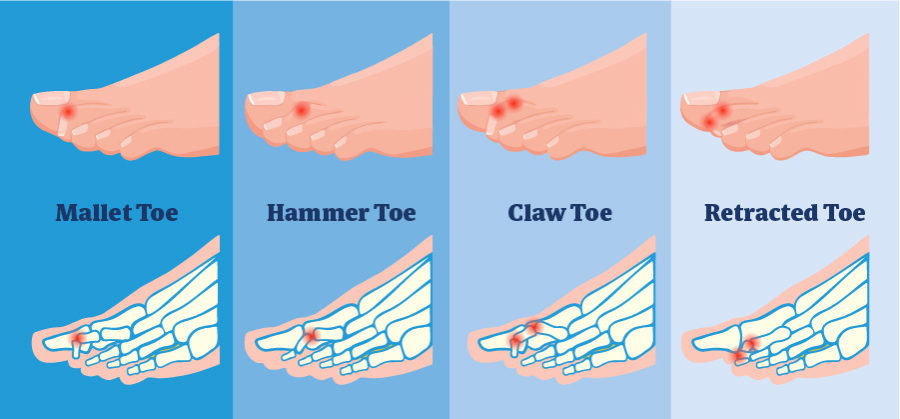WHAT IS HAMMERTOE AND MALLET TOE?
Hammertoe and mallet toe are foot defects which happen because of an imbalance in the muscles, tendons or ligaments which generally keep the toe straight. The type of shoes you wear, foot structure, trauma and specific disease processes could contribute to the development of these defects.
A hammertoe has an uncommon bend in the middle joint of a toe. Mallet toe damages the joint closest to the toenail. Hammertoe and mallet toe generally happen in your second, third and fourth toes.
Easing the pain and compression of hammertoe and mallet toe might include altering your footwear and wearing shoe inserts or foot orthosis. If you have a more serious case of hammertoe or mallet toe, you may require surgery to get relief.
HAMMERTOE SYMPTOMS
Hammertoe and mallet toe feature an uncommon bend in the joints of one or more of your toes. Moving the damaged toe might be hard or painful. Corns and calluses could result from the toe rubbing against the inside of your shoes.
HAMMERTOE CAUSES
Hammertoe and mallet toe have been connected to:
- Specific shoes – High-heeled shoes or footwear that is too tight in the toe box could crowd your toes into a space in which they cannot lie flat. This curled toe position may eventually persist even when you are barefoot.
- Trauma –A wound or injury in which you truncate, pinch or break a toe could make it more susceptible for that figure to develop hammertoe or mallet toe.
- Unusual balance of the toe muscles – The imbalance leads to instability, which could cause the toe to contract.

RISK FACTORS
Factors which could increase your risk of hammertoe and mallet toe include:
- Age – The risk of hammertoe and mallet toe increases as you get older.
- Sex – Women are much more likely to develop hammertoe or mallet toe as compared to men.
- Toe length – If your second toe is longer as compared to your big toe, it is at greater risk of hammertoe or mallet toe.
- Specific diseases – Arthritis and diabetes may make you more prone to developing foot defects. Heredity may also play a role.
HAMMERTOE COMPLICATIONS
In the early stages, a hammertoe or mallet toe may maintain its flexibility. But eventually, the tendons of the toe could contract and tighten, causing your toe to become permanently bent. Your shoes could rub against the raised portion of the toe or toes, causing painful corns or calluses.

HAMMERTOE PREVENTION
You could circumvent several foot, heel and ankle problems with shoes which fit perfectly. Here’s what you should look for when shopping for shoes:
- Adequate toe room – Circumvent shoes with pointed toes.
- Low heels – Circumventing high heels will help you avoid back problems.
- Adjustability – Laced or strapped shoes are broader and adjustable.
These additional tips could help you buy the right shoes:
- Buy shoes at the end of the day – Your legs swell throughout the day.
- Check your size – As you get older, your shoe size may change particularly the width. Measure the two feet and purchase for the biggest foot.
- Buy shoes which fit – Be sure shoes are comfortable before you buy them. If required, a shoe repair store may be able to stretch shoes in tight spots, but it is better to buy them to fit.
DIAGNOSIS
Your doctor or primary care physician could diagnose hammertoe or mallet toe by assessing your foot. Your primary care physician might order X-rays to further assess the bones and joints of your feet and toes.

HAMMERTOE TREATMENT
If your toe is still flexible, your primary care physician may suggest that you change to broader, more comfortable footwear and that you wear shoe inserts or orthotics or pads. Inserts or pads could reposition your toe and ease pressure and pain.
In addition, your primary care physician may recommend exercises like picking up marbles or crumpling a towel with your toes to stretch and strengthen your toe muscles.
If conservative treatments do not help, your primary care physician may suggest surgery to release the tendon that is preventing your toe from lying flat. In some cases, the surgeon also may remove a piece of bone to straighten your toe.
If you or anyone you know is suffering from hammertoe and mallet toe related problems, our expert providers at Specialty Care Clinics will take care of your health and help you recover.
Call 469-805-4561 to book an telehealth appointment for an at home check-up.
